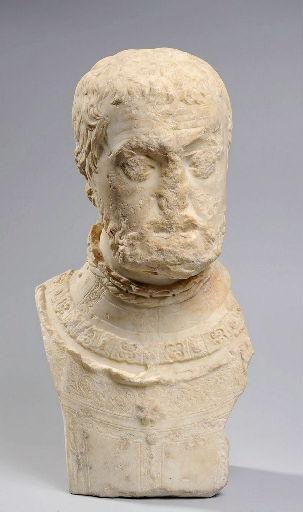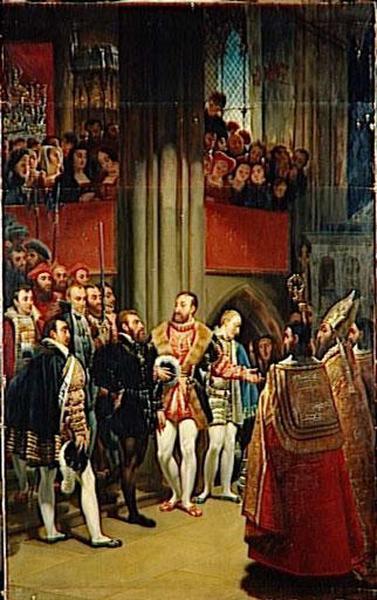Environ 30 résultats pour « Charles Quint »
-

Charles Quint
Charles de Habsbourg, archiduc d'Autriche et prince des Espagnes, né le 24 février 1500 au Prinsenhof de Gand en Flandre, et mort le 21 septembre 1558 au monastère de Yuste dans la province d'Estrémadure en Espagne, est un prince de la maison de Habsbourg, considéré comme le monarque chrétien le plus puissant de son temps. Il a été duc de Bourgogne (souverain des Pays-Bas) sous le nom de Charles II, roi des Espagnes, sous le nom de Charles I (Carlos I), roi de Naples et de Sicile, mais il est resté à la postérité sous son nom d'empereur du Saint-Empire romain germanique, Charles Quint (Karl V. ) (Quint signifiant cinquième en moyen français). Excepté cette dernière dignité, élective, cette accumulation de titres est le résultat involontaire d'une intense politique d'alliances matrimoniales qui a, faute d'autres prétendants, abouti à faire de Charles le seul héritier de cinq dynasties. Il est le dernier empereur germanique à nourrir le rêve carolingien d'un Empire prenant la tête de la Chrétienté. Cette ambition d'unité chrétienne face à la poussée du monde musulman dans les Balkans et en Méditerranée est brisée par l'opposition farouche et ininterrompue des rois de France François I et Henri II, ainsi que par la rupture religieuse provoquée par Martin Luther et les Réformes protestantes à partir de 1517. Ces deux conflits extérieurs occupent ses finances et son énergie pendant tout son règne, tandis que des révoltes intérieures en Castille, en Allemagne et dans les Flandres, affaiblissent par moment les bases de son pouvoir. Au terme d'une vie de combats et de voyages, miné et désabusé par ses échecs face à la France, aux luthériens et à sa propre famille, il finit par abdiquer et se dépouille en quelques années de ses possessions. Le 25 octobre 1555, il abdique en son palais de Bruxelles, cèdant les Flandres, désormais unies et déliées du Saint-Empire, à son fils Philippe, déjà duc de Milan et roi de Naples. Il lui cèdera également les Espagnes l'année suivante et la Franche-Comté au seuil de la mort. Par une série de conventions avec son frère Ferdinand, il avait cédé dès les années 1550 les duchés autrichiens à ce dernier. Fort de cette base germanique, c'est lui qui héritera de la couronne impériale à la mort de son frère.
-

CHARLES QUINT RECU PAR FRANCOIS IER A L'ABBAYE DE SAINT DEN…
-
- Domaine(s) :
- Peinture
-
- Sujet représenté :
- Charles Quint
- Foule
- François Ier de France
- Saint-Denis (Seine-Saint-Denis)
- Évêque
-
- Datation :
- XIXe siècle
-
-

-
- Artiste(s) :
- Anonyme
COURONNEMENT DU PAPE CELESTIN V (1294)
-
- Domaine(s) :
- Peinture
-
- Sujet représenté :
- Cardinal (religion)
- Charles Quint
- Célestin V
- François Ier de France
- Homme
- Palais
-
- Datation :
- XVIe siècle
-
-

-
- Artiste(s) :
- Anonyme
CHARLES-QUINT, EMPEREUR D'ALLEMAGNE (1500-1558)
-
- Domaine(s) :
- Peinture
-
- Sujet représenté :
- Charles Quint
- Homme
-
- Datation :
- XVIIe siècle
-
-

-
- Artiste(s) :
- Anonyme
PORTRAIT DE CHARLES QUINT EN COSTUME DE CHEVALIER DE LA TOI…
-
- Domaine(s) :
- Peinture
-
- Datation :
- XVIIe siècle
-
-

-
- Artiste(s) :
- Anonyme
CHARLES-QUINT, EMPEREUR D'ALLEMAGNE (1500-1558)
-
- Domaine(s) :
- Peinture
-
- Sujet représenté :
- Charles Quint
- Homme
- Portrait
-
- Datation :
- XVIIe siècle
-
-

-
- Artiste(s) :
- Frans II Francken
PRESENTATION DE LA SAINTE TUNIQUE A CHARLES QUINT
-
- Domaine(s) :
- Peinture
-
- Sujet représenté :
- Armure (équipement)
- Charles Quint
- Foule
- Militaire
- Mise au tombeau
- Reliquaire
-
- Datation :
- XVIIe siècle
-
-

-
- Artiste(s) :
- Anonyme
- Christoph Amberger
PORTRAIT DE CHARLES QUINT
-
- Domaine(s) :
- Peinture
-
- Sujet représenté :
- Bijou
- Charles Quint
- Col (vêtement)
- Dentelle
- Gant
- Livre (document)
-
- Datation :
- XVIe siècle
-
-

-
- Artiste(s) :
- Pierre-Nolasque Bergeret
Charles Quint ramassant le pinceau de Titien
-
- Domaine(s) :
- Peinture
-
- Sujet représenté :
- Artiste peintre
- Charles Quint
- Empereur
- Gant
- Homme
- Instrument à cordes
- …
-
- Datation :
- XIXe siècle
-
-

CHARLES-QUINT (1500-1558)
-
- Domaine(s) :
- Peinture
-
- Sujet représenté :
- Armure (équipement)
- Barbe
- Charles Quint
- Homme
- Portrait
-
- Datation :
- XVIe siècle
-
-

-
- Artiste(s) :
- Paul Véronèse
LES NOCES DE CANA
-
- Domaine(s) :
- Peinture
-
- Sujet représenté :
- Andrea Palladio
- Architecte
- Architecture
- Artiste peintre
- Balustrade
- Banquet
- …
-
- Datation :
- XVIe siècle
-
-

ENFANCE DE CHARLES QUINT ; UNE LECTURE D'ERASME (BRUXELLES,…
-
- Sujet représenté :
- Charles Quint
- Garçon
- Lecture
- Livre (document)
- Tapisserie
- Trône
-
- Datation :
- XIXe siècle
-

-
- Artiste(s) :
- Anonyme
CHARLES QUINT
-
- Domaine(s) :
- Peinture
-
- Sujet représenté :
- Bonnet (vêtement)
- Charles Quint
- Homme
- Portrait
- Volumen
-
- Datation :
- XVIe siècle
-
-

-
- Artiste(s) :
- Titien
PORTRAIT DE CHARLES QUINT
-
- Domaine(s) :
- Peinture
-
- Sujet représenté :
- Bijou
- Charles Quint
- Décoration (honorifique)
- Homme
- Portrait
-
- Datation :
- XVIIe siècle
-
-

-
- Artiste(s) :
- Anonyme
CHARLES QUINT JEUNE (1500-1558)
-
- Domaine(s) :
- Peinture
-
- Sujet représenté :
- Chapeau
- Charles Quint
- Homme
- Portrait
-
- Datation :
- XVIe siècle
-
-

-
- Artiste(s) :
- Anonyme
CHARLES QUINT JEUNE (1500-1558)
-
- Domaine(s) :
- Peinture
-
- Sujet représenté :
- Chapeau
- Charles Quint
- Homme
- Portrait
-
- Datation :
- XVIe siècle
-
-

-
- Artiste(s) :
- Frans I Francken
PRISE D'HABIT DE CHARLES QUINT
-
- Sujet représenté :
- Chandelle (éclairage)
- Charles Quint
- Homme
-
- Datation :
- XVIIe siècle
-
-

-
- Artiste(s) :
- Anonyme
Portrait de Charles-Quint
-
- Domaine(s) :
- Peinture
-
- Sujet représenté :
- Charles Quint
- Portrait
-
- Datation :
- XVIe siècle
-
-

Portrait de Charles Quint
-
- Domaine(s) :
- Peinture
-
- Sujet représenté :
- Charles Quint
- Portrait
-
- Datation :
- XVIe siècle
-
-

-
- Artiste(s) :
- Manufacture des Gobelins
Les Chasses de l'Empereur Maximilien : Le repas de chasse (…
-
- Domaine(s) :
- Tapisserie
-
- Datation :
- XVIIIe siècle
-
-

-
- Artiste(s) :
- Anonyme
- Gaspard de Crayer
Couronnement de l'empereur Charles Quint à Bologne
-
- Sujet représenté :
- Charles Quint
- Foule
- Noblesse
- Pape
-
- Datation :
- XVIIe siècle
-
-

Le Titien (Tiziano Vecellio, dit) (Pieve di Cadore,1488/148…
-
- Domaine(s) :
- Sculpture
-
- Sujet représenté :
- Artiste peintre
- Barbe
- Bijou
- Bonnet (vêtement)
- Charles Quint
- Fourrure
-
- Datation :
- XIXe siècle
-
-

-
- Artiste(s) :
- Jean-Auguste-Dominique Ingres
L'Arétin et l'envoyé de Charles Quint (Ensemble de la compo…
-
- Domaine(s) :
- Dessin
-
- Sujet représenté :
- Charles Quint
- Pierre l'Arétin
- Poésie
-
- Datation :
- XIXe siècle
-
-

CHATEAU DE CHAMBORD (titre inscrit)
-
- Domaine(s) :
- Estampe
-
- Sujet représenté :
- Chambord (Loir-et-Cher)
- Charles Quint
- Château
- François Ier de France
- Visite d'État
-
- Datation :
- XIXe siècle
- XXe siècle
-
-

Charles Quint
-
- Domaine(s) :
- Estampe
-
- Sujet représenté :
- Armure (équipement)
- Charles Quint
- Couronne (attribut)
- Homme
- Laurus nobilis
- Portrait
-
- Datation :
- XIXe siècle
-
-

-
- Artiste(s) :
- Antoine-Jean Gros
François Ier et Charles Quint
-
- Domaine(s) :
- Estampe
-
- Datation :
- XIXe siècle
-
-

Portrait de Charles Quint
-
- Domaine(s) :
- Peinture
-
- Sujet représenté :
- Chapeau
- Charles Quint
- Homme
- Ordre de la Toison d'or
- Portrait
-
- Datation :
- XVIe siècle
-
-

Charles Quint
-
- Domaine(s) :
- Sculpture
-
- Sujet représenté :
- Armure (équipement)
- Barbe
- Charles Quint
- Empereur
- Homme
- Portrait
-
- Datation :
- XVIe siècle
-
-

-
- Artiste(s) :
- Paul Véronèse
Les noces de Cana
-
- Domaine(s) :
- Estampe
-
- Sujet représenté :
- Andrea Palladio
- Architecte
- Architecture
- Artiste peintre
- Balustrade
- Banquet
- …
-
- Datation :
- XIXe siècle
- XVIIIe siècle
-
-

-
- Artiste(s) :
- Adriaen Collaert
Vienne défendue contre les Turcs par Charles Quint
-
- Domaine(s) :
- Estampe
-
- Sujet représenté :
- Armée
- Canon (artillerie)
- Cavalerie
- Charles Quint
- Infanterie
- Turcs (peuple)
-
- Datation :
- XVIe siècle
-

